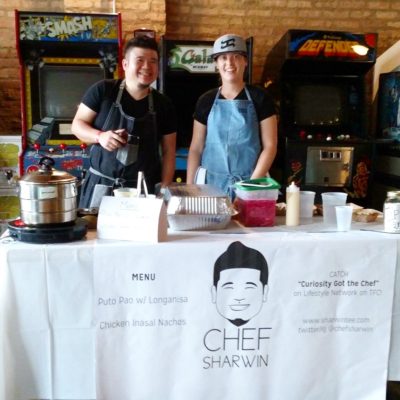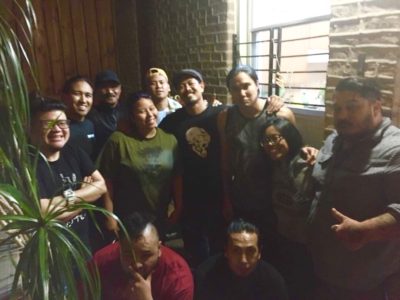 As I sit down in the radio booth of WGN Chicago to do promos for the Kultura Festival by Filipino Kitchen, I mentally go through my cache of standard answers. I am the ringer, the chef “all the way from Manila” who would be talking about Filipino food, brought in to entice the people of Chicago to understand what Filipino food was and try it at the festival.
As I sit down in the radio booth of WGN Chicago to do promos for the Kultura Festival by Filipino Kitchen, I mentally go through my cache of standard answers. I am the ringer, the chef “all the way from Manila” who would be talking about Filipino food, brought in to entice the people of Chicago to understand what Filipino food was and try it at the festival.
“So chef, tell us, what is Filipino food?” They ask, as expected. Before I could access my standard answer, my thoughts float back to the apartment I was staying in (with 8 other Filipinos).
“Well, most of what we do would be considered illegal,”
Joseph candidly responds, when I ask him why there aren’t more Filipino Martial Arts (FMA) practitioners in the Ultimate Fighting Championship (UFC). Joseph, despite not being a particularly big or tall man, sits across from me at the kitchen table with a certain presence that’ll make you not want to pick a fight with him. He mentions how most of FMA involves “defanging the opponent,” meaning you attack the limbs of the opponent that attack you in order to disarm and incapacitate him. That’s what sets FMA apart, he says. “Remember,” he continues, “Filipinos developed these martial arts to protect themselves from the colonizers. They had to hide them as traditional dances.” I wanted to commend him for taking the time to spread the word about FMA but before I could go any deeper, he opens up. “One of the reasons I got into FMA is to find a connection with my culture. Maybe I don’t speak the language (Filipino), I’m not updated on who is popular in Filipino showbiz, but that doesn’t make me any less FIlipino.”

“So which province are you from?”
Lane Wilcken asks as I ask him about maybe getting a tattoo. “How I begin to give the person a tattoo is I ask about their ancestry.” Lane is one of only 5 “Mambabatoks,” traditional Filipino tattoo artists who do Hand Tap Tatoos. He’s in Chicago also to give a workshop on tatooing. When I mention my mother is from Davao, he lights up and asks me if I’m from a particular tribe. As much as I have travelled over the years, I have never even heard of that tribe, but I do mention my Chinese ethnicity and he understands. “Perhaps we can do some Chinese characters then. That might be more appropriate.” This whole conversation was a lot deeper into Filipino culture than I had anticipated. Lane laments how the art of tattooing has become taboo in other people’s eyes. “Before the colonizers arrived, we were known as Las Islas de Pintados,” referring to how the native Filipinos were tattooed. It all just got lost over the years as the Filipinos were colonized.
“Anytime, man. Just let us know.”
Joe Aquilizan and Kristian Kabuay are as accommodating as I had first met them last March as I broach on a collaborative idea. Joe is the man at Bayani Art, an apparel company that sells hats, shirts and the like that feature Philippine heroism and history, with part of its proceeds going to help the National Museum in the Philippines. His help extends elsewhere too. “I let this struggling company use my designs to help them make money. I didn’t charge them anything but I told them to donate my share to my charities. The company has survived now, and I’m pretty happy about that.” Meanwhile, Kristian is an expert on Baybayin, the pre-colonial Filipino alphabet. The former model is often quiet, which doesn’t indicate his deep passion for the Philippine culture. “You know how most menus of other ethnic cuisines have their original script even if no one can read them? I don’t know why we don’t do the same with Filipino restaurants. They can call me and I’d be happy to work on it with them. We need to put it (baybayin) out there.”

“Filipino food is not the next big thing coming up. It is already there.”
Natalia Roxas and Sarahlynn Pablo are talking shop while driving me around Chicago. The ladies own Filipino Kitchen, a Filipino food, media and events company but don’t tell them that. Together with Project Manager Caitlin Preminger, they know that what they do is more. “Filipino food is history on a plate,” they believe and if there are poor souls who try to appropriate Filipino food into something else, they will make you take it back, sometimes literally. They are at the forefront of pushing Filipino food, using it to promote the culture and they want everyone to know that it stands on its own.
“It’s beautiful, man. Just beautiful.”
Robert Castro is happy as he tells me what he thinks of the Kultura Festival weekend. Grand Master, GM for short, joins Joseph to demonstrate Eskabo Daan, the FMA combining the forms of Escrima, Kali, Jeet Koon Do and Boxing. He is excited to see young people from the different cities of the USA, Canada and Manila come together to celebrate Filipino pride. “I came here to the US at the age of 2. Growing up, some Filipinos would get lynched, man. That’s how hard it was for us here,” GM recalls. “But now, seeing all of us come together, it’s just beautiful.”

“Filipino food has always been about family.”
So my thoughts come back to the radio booth and I struggle to give a concise answer. “If you’ve got a day, I can give you a complete answer.” Everyone chuckles, but I sort of meant it. Filipino food has always been more about stories than ingredients. It’s always been more about passion than technique.
In our apartment, I met wonderful Filipinos and they filled me with their stories of determination, history, discipline, generosity, pride, passion, patience and love. They have become my family. That’s how I knew I left Chicago with more knowledge about Filipino food than ever before. I take home with me more stories, more passion, and more love for the Philippines. I take home with me more fuel to make more Filipino food.
Comments are closed.